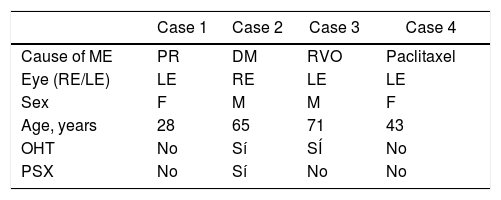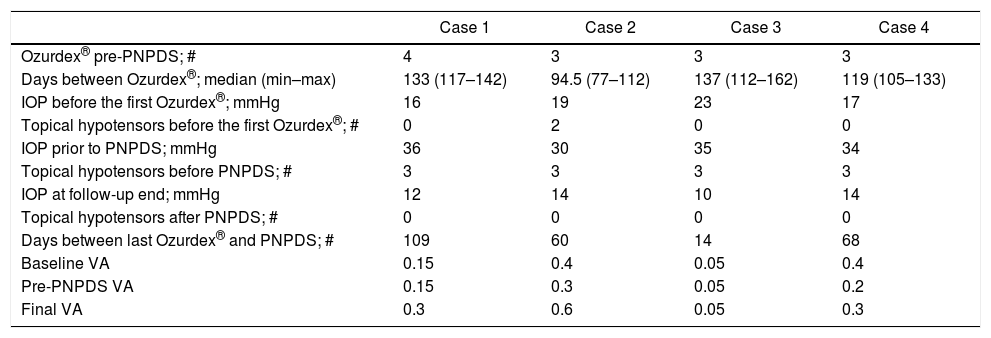To evaluate the characteristics and progression of patients treated with a 0.7mg dexamethasone intravitreal implant (Ozurdex®) and required glaucoma filtering surgery (phaco-non-penetrating deep sclerectomy) to control ocular hypertension (OHT).
MethodsA retrospective observational study including patients treated with Ozurdex® in a tertiary-care university hospital from May 2011 to April 2016.
ResultsIn five years of follow-up, 1.10% (4/363) of patients treated with 0.7mg dexamethasone intravitreal implant required phaco-non-penetrating deep sclerectomy (PNPDS) to control OHT refractory to topical treatment. All four patients started or increased previous antihypertensive topical treatment since the first dexamethasone intravitreal implant. Three or more dexamethasone intravitreal implants were injected in the four cases before intraocular pressure (IOP) became uncontrolled and PNPDS was performed. All four patients have a successfully controlled IOP without treatment after PNPDS. Two patients required additional treatment with dexamethasone intravitreal implants after PNPDS, maintaining IOP under control without treatment.
ConclusionsTo the best of our knowledge, this is the first study describing the successful results of PNPDS in OHT secondary to dexamethasone intravitreal implant. All four patients have achieved controlled IOP without treatment. Re-treatment with dexamethasone intravitreal implant in those patients who underwent PNPDS is also possible, and IOP remains controlled.
Evaluar las características y la evolución de los pacientes que requirieron cirugía filtrante de glaucoma (esclerectomía profunda no perforante) para controlar la hipertensión ocular (HTO) secundaria al implante intravítreo de 0,7mg de dexametasona (Ozurdex®).
MétodosSerie de casos observacional retrospectiva de pacientes tratados mediante Ozurdex® en un hospital terciario universitario entre mayo 2011 y abril 2016.
ResultadosEl 1,10% (4/363) de los pacientes tratados con Ozurdex® requirieron faco-esclerectomía profunda no perforante (FEPNP) para controlar la HTO secundaria refractaria a tratamiento médico hipotensor. Los 4 casos comenzaron el tratamiento tópico hipotensor o aumentaron su tratamiento hipotensor previo desde el primer implante intravítreo de Ozurdex®. Todos los casos habían recibido 3 o más inyecciones de Ozurdex® antes de que se requiriera la realización de la FEPNP para el control de la PIO. Tras el tratamiento quirúrgico, en todos los casos se alcanzó una PIO óptima sin necesidad de tratamiento tópico adicional. Dos pacientes requirieron retratamiento con nuevas inyecciones de Ozurdex® después de la FEPNP, manteniéndose la PIO dentro de los límites normales sin necesidad de tratamiento.
ConclusionesEsta es la primera serie de casos que aporta información acerca de los favorables resultados de la FEPNP como tratamiento de la HTO secundaria a implante intravítreo de Ozurdex®. Los 4 casos presentan una PIO controlada sin tratamiento tras la cirugía. El retratamiento con Ozurdex® en aquellos pacientes que se han sometido a FEPNP es posible, manteniéndose un buen control de la PIO.









